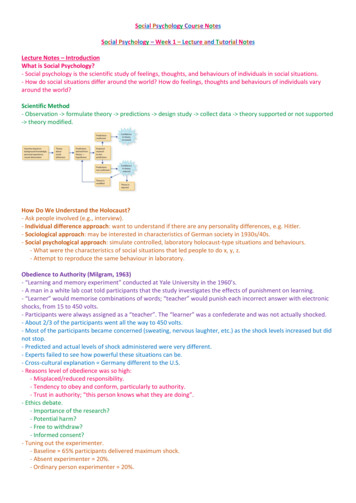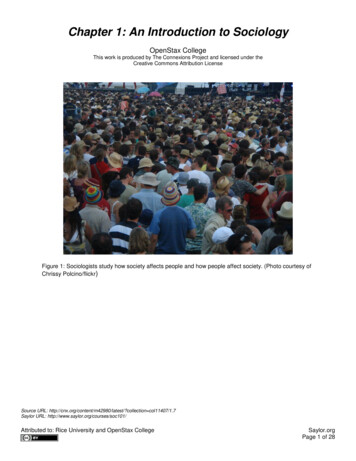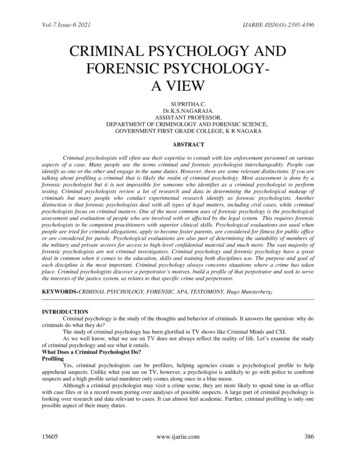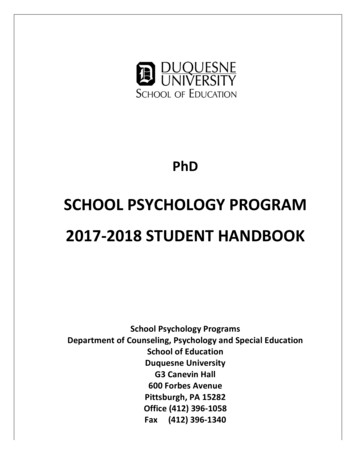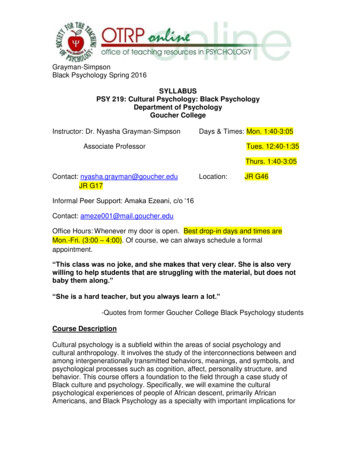
Transcription
This text was adapted by The Saylor Foundation under a CreativeCommons Attribution-NonCommercial-ShareAlike 3.0 License withoutattribution as requested by the work’s original creator or licensee.Saylor URL: http://www.saylor.org/booksSaylor.org1
PrefaceWhen I first started teaching social psychology, I had trouble figuring out how the various topics in thisexpansive field fit together. I felt like I was presenting a laundry list of ideas, research studies, andphenomena, rather than an integrated set of principles and knowledge. Of course, what was difficult forme was harder still for my students. How could they be expected to understand and remember all of themany topics that we social psychologists study? And how could they tell what was most important?Something was needed to structure and integrate their learning.It took me some time, but eventually, I realized that the missing piece in my lectures was a consistentfocus on the basic principles of social psychology. Once I started thinking and talking about principles,then it all fell into place. I knew that when I got to my lecture on altruism, most of my students alreadyknew what I was about to tell them. They understood that, although there were always some tweaks tokeep things interesting, altruism was going to be understood using the same ideas that conformity andperson perception had been in earlier lectures—in terms of the underlying fundamentals—they were trulythinking like social psychologists!I wrote this book to help students organize their thinking about social psychology at a conceptual level.Five or ten years from now, I do not expect my students to remember the details of a study published in2011, or even to remember most of the definitions in this book. I do hope, however, that they willremember some basic ideas, for it is these principles that will allow them to critically analyze newsituations and really put their knowledge to use.My text is therefore based on a critical thinking approach—its aim is to get students thinking actively andconceptually—with more of a focus on the forest than on the trees. Although there are right and wronganswers, the answers are not the only thing. What is perhaps even more important is how we get to thoseanswers—the thinking process itself. My efforts are successful when my students have that “aha” moment,in which they find new ideas fitting snugly into the basic concepts of social psychology.To help students better grasp the big picture of social psychology and to provide you with a theme thatyou can use to organize your lectures, my text has a consistent pedagogy across the chapters. I organizemy presentation around two underlying principles that are essential to social psychology:1. Person and situation (the classic treatment)2. The ABCs of social psychology (affect, behavior, and cognition)Saylor URL: http://www.saylor.org/booksSaylor.org2
I also frame much of my discussion around the two human motivations of self-concernand other-concern.I use these fundamental motivations to frame discussions on a variety of dimensions including altruism,aggression, prejudice, gender differences, and cultural differences. You can incorporate these dimensionsinto your teaching as you see fit.My years of teaching have convinced me that these dimensions are fundamental, that they are extremelyheuristic, and that they are what I hope my students will learn and remember. I think that you may findthat this organization represents a more explicit representation of what you’re already doing in yourlectures. Although my pedagogy is consistent, it is not constraining. You will use these dimensions morein some lectures than in others, and you will find them more useful for some topics than others. But theywill always work for you when you are ready for them. Use them to reinforce your presentation as you seefit.Perhaps most important, a focus on these dimensions helps us bridge the gap between the textbook, thereal-life experiences of our students, and our class presentations. We can’t cover every phenomenon inour lectures—we naturally let the textbook fill in the details. The goal of my book is to allow you to restassured that the text has provided your students with the foundations—the fundamental language ofsocial psychology—from which you can build as you see fit. And when you turn to ask students to applytheir learning to real life, you can know that they will be doing this as social psychologists do—using abasic underlying framework.OrganizationThe text moves systematically from lower to higher levels of analysis—a method that I have found makessense to students. On the other hand, the chapter order should not constrain you—choose a differentorder if you wish. Chapter 1 "Introducing Social Psychology" presents an introduction to social psychologyand the research methods in social psychology, Chapter 2 "Social Learning and Social Cognition" presentsthe fundamental principles of social cognition, and Chapter 3 "Social Affect" focuses on social affect. Theremainder of the text is organized around three levels of analysis, moving systematically from theindividual level (Chapter 4 "The Self" through Chapter 6 "Perceiving Others"), to the level of socialinteraction (Chapter 7 "Influencing and Conforming" through Chapter 10 "Aggression"), to the group andcultural level (Chapter 11 "Working Groups: Performance and Decision Making" through Chapter 13"Competition and Cooperation in Our Social Worlds").Saylor URL: http://www.saylor.org/booksSaylor.org3
Rather than relying on “modules” or “appendices” of applied materials, my text integrates appliedconcepts into the text itself. This approach is consistent with my underlying belief that if students learn tothink like social psychologists they will easily and naturally apply that knowledge to any and allapplications. The following applications are woven throughout the text: Business and consumer behavior (see, for instance, Chapter 5 "Attitudes, Behavior, andPersuasion" on marketing and persuasion and Chapter 11 "Working Groups:Performance and Decision Making" on group decision-making) Health and Behavior (see, for instance, Chapter 3 "Social Affect" on stress andChapter 6"Perceiving Others" on attributional styles) Law (see, for instance, Chapter 2 "Social Learning and Social Cognition" on eyewitnesstestimony and Chapter 10 "Aggression" on Terrorism)PedagogyPrinciples of Social Psychology contains a number of pedagogical features designed to help studentsdevelop an active, integrative understanding of the many topics of social psychology and to think likesocial psychologists.Research FociResearch is of course the heart of social psychology, and the research foci provide detailed informationabout a study or research program. I’ve chosen a mix of classic and contemporary research, with a focuson both what’s interesting and what’s pedagogical. Rather than boxing these findings, they are part of therunning text—simply highlighted with a heading and light shading.Social Psychology in the Public InterestSocial psychological findings interest students in large part because they relate so directly to everydayexperience. The Social Psychology in the Public Interest Feature reinforces these links. Topics includeDoes High Self-Esteem Cause Happiness or Other Positive Outcomes? (Chapter 3 "Social Affect"),Detecting Deception (Chapter 6 "Perceiving Others"), Terrorism as Instrumental Aggression (Chapter 10"Aggression"), and Stereotype Threat in Schools (Chapter 12 "Stereotypes, Prejudice, andDiscrimination"). The goal here is to include these applied topics within the relevant conceptualdiscussions to provide students with a richer understanding within the context of the presentation.Thinking Like a Social PsychologistSaylor URL: http://www.saylor.org/booksSaylor.org4
Each chapter ends with a section that summarizes how the material presented in the chapter can help thestudent think about contemporary issues using social psychological principles. This section is designed towork with the chapter summary to allow a better integration of fundamental concepts.Saylor URL: http://www.saylor.org/booksSaylor.org5
Chapter 1Introducing Social PsychologyMass Suicide of 39 Cult Members Shocks NationOn March 26, 1997, people were found dead in a house on a hilltop in San Diego, California. The peoplewere members of a cult and were part of a carefully orchestrated suicide that involved sedatives, vodka,and plastic bags. There were 21 women and 18 men, and they had come to California from across thecountry. Most of the victims were in their 40s, but ages ranged from 26 to 72.The name of the cult was “Heaven’s Gate,” and it also operated a computer web service called “HigherSource.” The victims evidently believed that they were going to meet a UFO hiding behind the cometHale-Bopp, and the suicides occurred during the time that the comet was closest to earth.The suicide probably took place over three days and seemed to have been calm and ritualistic. One groupof cult members apparently helped some other members die, cleaned up after them, and then went on totake their own doses of poison, which was mixed with apple sauce or pudding. The last two victims hadplastic bags over their heads.“It seemed to be a group decision,” said Dr. Brian Blackbourne, San Diego County medical examiner.“There were different stages, suggesting it was planned. They all had IDs. The house was immaculate.”“We’re not talking about a drug-crazed, party-time situation The drugs were taken for a very specificpurpose and that was to take their own lives.”The victims all wore black pants and black Nike sports shoes, and their faces and chests were covered inpurple shrouds. The victims had carefully packed their bags and placed their few possessions at theirsides. Most of the victims had a 5 bill and some quarters in their pockets.There was no blood found at the scene, and the only weapon in the home was a 9 mm pistol packed in abag.Jerry Lipscomb of the San Diego Sheriff’s Department told CNN, “What we’re finding is that each andevery one of the members of the organization, prior to their death, gave a brief statement The essence ofthose statements was that they were going to a better place.”“It’s our opinion that it was their intent—they planned to do this.”Saylor URL: http://www.saylor.org/booksSaylor.org6
Source: Mass suicide involved sedatives, vodka and careful planning. CNN.com. Retrievedfrom ml.Social psychology is the scientific study of how we feel about, think about, and behave toward the peoplearound us and how our feelings, thoughts, and behaviors are influenced by those people. As this definitionsuggests, the subject matter of social psychology is very broad and can be found in just about everythingthat we do every day. Social psychologists study why we are often helpful to other people and why we mayat other times be unfriendly or aggressive. Social psychologists study both the benefits of having goodrelationships with other people and the costs of being lonely. Social psychologists study what factors leadpeople to purchase one product rather than another, how men and women behave differently in socialsettings, how juries work together to make important group decisions, and what makes some people morelikely to recycle and engage in other environmentally friendly behaviors than others. And socialpsychologists also study more unusual events, such as how some people can be persuaded that a UFO ishiding behind a comet, leading them to take their own lives as part of a suicide cult.The goal of this book is to help you learn to think about social behaviors in the same way that socialpsychologists do. I believe you will find this approach useful because it will allow you to think abouthuman behavior more critically and more objectively and to gain insight into your own relationships withother people. Social psychologists study everyday behavior scientifically, and their research creates auseful body of knowledge about our everyday social interactions.1.1 Defining Social Psychology: History and PrinciplesLEARNING OBJECTIVES1.Define social psychology.2. Review the history of the field of social psychology and the topics that socialpsychologists study.3. Summarize the principles of evolutionary psychology.4. Describe and provide examples of the person-situation interaction.5. Review the concepts of (a) social norms and (b) cultures.The field of social psychology is growing rapidly and is having an increasingly important influence on howwe think about human behavior. Newspapers, websites, and other media frequently report the findings ofSaylor URL: http://www.saylor.org/booksSaylor.org7
social psychologists, and the results of social psychological research are influencing decisions in a widevariety of areas. Let’s begin with a short history of the field of social psychology and then turn to a reviewof the basic principles of the science of social psychology.The History of Social PsychologyThe science of social psychology began when scientists first started to systematically and formallymeasure the thoughts, feelings, and behaviors of human beings (Kruglanski & Stroebe, 2011).[1]Theearliest social psychology experiments on group behavior were conducted before 1900 (Triplett,1898),[2]and the first social psychology textbooks were published in 1908 (McDougall, 1908/2003; Ross,1908/1974).[3]During the 1940s and 1950s, the social psychologists Kurt Lewin and Leon Festingerrefined the experimental approach to studying behavior, creating social psychology as a rigorous scientificdiscipline. Lewin is sometimes known as “the father of social psychology” because he initially developedmany of the important ideas of the discipline, including a focus on the dynamic interactions amongpeople. In 1954, Festinger edited an influential book called Research Methods in the Behavioral Sciences,in which he and other social psychologists stressed the need to measure variables and to use laboratoryexperiments to systematically test research hypotheses about social behavior. He also noted that it mightbe necessary in these experiments to deceive the participants about the true nature of the research.Social psychology was energized by researchers who attempted to understand how the German dictatorAdolf Hitler could have produced such extreme obedience and horrendous behaviors in his followersduring the Second World War. The studies on conformity conducted by Muzafir Sherif (1936)[5]Solomon Asch (1952), as well as those on obedience by Stanley Milgram (1974),[6][4]andshowed theimportance of conformity pressures in social groups and how people in authority could create obedience,even to the extent of leading people to cause severe harm to others. Philip Zimbardo, in his well-known“prison experiment” (Haney, Banks, & Zimbardo, 1973),[7]found that ordinary male college students whowere recruited to play the roles of guards and prisoners in a simulated prison became so involved in theirassignments, and their interaction became so violent, that the study had to be terminated early (Note 1.4"Video Clip 1"). This research again demonstrated the power of the social setting.Video Clip 1The Stanford prison experiment conducted by Philip Zimbardo in the 1960s demonstrated the powerfulrole of the social situation on human behavior.Saylor URL: http://www.saylor.org/booksSaylor.org8
Social psychology quickly expanded to study other topics. John Darley and Bibb Latané(1968)[8]developed a model that helped explain when people do and do not help others in need, andLeonard Berkowitz (1974)[9]pioneered the study of human aggression. Meanwhile, other socialpsychologists, including Irving Janis (1972),[10]focused on group behavior, studying why intelligent peoplesometimes made decisions that led to disastrous results when they worked together. Still other socialpsychologists, including Gordon Allport and Muzafir Sherif, focused on intergroup relations, with the goalof understanding and potentially reducing the occurrence of stereotyping, prejudice, and discrimination.Social psychologists gave their opinions in the 1954 Brown v. Board of Education Supreme Court casethat helped end racial segregation in U.S. public schools, and social psychologists still frequently serve asexpert witnesses on these and other topics (Fiske, Bersoff, Borgida, Deaux, & Heilman, 1991).[11]The latter part of the 20th century saw an expansion of social psychology into the field of attitudes, with aparticular emphasis on cognitive processes. During this time, social psychologists developed the firstformal models of persuasion, with the goal of understanding how advertisers and other people couldpresent their messages to make them most effective (Eagly & Chaiken, 1993; Hovland, Janis, & Kelley,1963).[12]These approaches to attitudes focused on the cognitive processes that people use whenevaluating messages and on the relationship between attitudes and behavior. Leon Festinger’s(1957)[13]important cognitive dissonance theory was developed during this time and became a model forlater research.In the 1970s and 1980s, social psychology became even more cognitive in orientation as socialpsychologists used advances in cognitive psychology, which were themselves based largely on advances incomputer technology, to inform the field (Fiske & Taylor, 2008).[14]The focus of these researchers,including Alice Eagly, Susan Fiske, E. Tory Higgins, Richard Nisbett, Lee Ross, Shelley Taylor, and manyothers, was on social cognition—an understanding of how our knowledge about our social worldsdevelops through experience and the influence of these knowledge structures on memory, informationprocessing, attitudes, and judgment. Furthermore, the extent to which humans’ decision making could beflawed by both cognitive and motivational processes was documented (Kahneman, Slovic, & Tversky,1982).[15]In the 21st century, the field of social psychology has been expanding into still other areas. Examples thatwe will consider in this book include an interest in how social situations influence our health andSaylor URL: http://www.saylor.org/booksSaylor.org9
happiness, the important roles of evolutionary experiences and cultures on our behavior, and the fieldof social neuroscience—the study of how our social behavior both influences and is influenced by theactivities of our brain (Lieberman, 2010).[16]Social psychologists continue to seek new ways to measureand understand social behavior, and the field continues to evolve. I cannot predict where socialpsychology will be directed in the future, but I have no doubt that it will still be alive and vibrant.The Person and the Social SituationSocial psychology is the study of the dynamic relationship between individuals and the people aroundthem (see Figure 1.1 "The Person-Situation Interaction"). Each of us is different, and our individualcharacteristics, including our personality traits, desires, motivations, and emotions, have an importantimpact on our social behavior. But our behavior is also profoundly influenced by the social situation—thepeople with whom we interact every day. These people include our friends and family, our fraternitybrothers or sorority sisters, our religious groups, the people we see on TV or read about or interact with onthe web, as well as people we think about, remember, or even imagine.Figure 1.1 The Person-Situation InteractionSocial psychologists believe that human behavior is determined by both a person’s characteristicsand the social situation. They also believe that the social situation is frequently a stronger influenceon behavior than are a person’s characteristics.Social psychology is largely the study of the social situation. Our social situations create socialinfluence, the process through which other people change our thoughts, feelings, and behaviors andSaylor URL: http://www.saylor.org/booksSaylor.org10
through which we change theirs. Maybe you can already see how the social influence provided by themembers of the Heaven’s Gate cult was at work in the Hale-Bopp suicide.Kurt Lewin formalized the joint influence of person variables and situational variables, which is known asthe person-situation interaction, in an important equation:Behavior f (person, social situation).Lewin’s equation indicates that the behavior of a given person at any given time is a function of (dependson) both the characteristics of the person and the influence of the social situation.Evolutionary Adaptation and Human CharacteristicsIn Lewin’s equation, person refers to the characteristics of the individual human being. People are bornwith skills that allow them to successfully interact with others in their social world. Newborns are able torecognize faces and to respond to human voices, young children learn language and develop friendshipswith other children, adolescents become interested in sex and are destined to fall in love, most adultsmarry and have children, and most people usually get along with others.People have these particular characteristics because we have all been similarly shaped through humanevolution. The genetic code that defines human beings has provided us with specialized social skills thatare important to survival. Just as keen eyesight, physical strength, and resistance to disease helped ourancestors survive, so too did the tendency to engage in social behaviors. We quickly make judgmentsabout other people, help other people who are in need, and enjoy working together in social groupsbecause these behaviors helped our ancestors to adapt and were passed along on their genes to the nextgeneration (Ackerman & Kenrick, 2008; Barrett & Kurzban, 2006; Pinker, 2002).[17]Our extraordinarysocial skills are primarily due to our large brains and the social intelligence that they provide us with(Herrmann, Call, Hernández-Lloreda, Hare, & Tomasello, 2007).[18]The assumption that human nature, including much of our social behavior, is determined largely by ourevolutionary past is known as evolutionary adaptation(Buss & Kenrick, 1998; Workman & Reader,2008).[19]In evolutionary theory,fitnessrefers to the extent to which having a given characteristic helpsthe individual organism to survive and to reproduce at a higher rate than do other members of thespecies who do not have the characteristic. Fitter organisms pass on their genes more successfully to latergenerations, making the characteristics that produce fitness more likely to become part of the organisms’nature than are characteristics that do not produce fitness. For example, it has been argued that theSaylor URL: http://www.saylor.org/booksSaylor.org11
emotion of jealousy has survived over time in men because men who experience jealousy are more fit thanmen who do not. According to this idea, the experience of jealousy leads men to protect their mates andguard against rivals, which increases their reproductive success (Buss, 2000).[20]Although our biological makeup prepares us to be human beings, it is important to remember that ourgenes do not really determine who we are. Rather, genes provide us with our human characteristics, andthese characteristics give us the tendency to behave in a “human” way. And yet each human being isdifferent from every other human being.Evolutionary adaption has provided us with two fundamental motivations that guide us and help us leadproductive and effective lives. One of these motivations relates to the self—the motivation to protect andenhance the self and the people who are psychologically close to us; the other relates to the socialsituation—the motivation toaffiliate with, accept, and be accepted by others. We will refer to these twomotivations as self-concern and other-concern respectively.Self-ConcernThe most basic tendency of all living organisms, and the focus of the first human motivation, is the desireto protect and enhance one’s own life and the lives of the people who are close to us. Humans aremotivated to find food and water, to obtain adequate shelter, and to protect themselves from danger.Doing so is necessary because we can survive only if we are able to meet these fundamental goals.The desire to maintain and enhance the self also leads us to do the same for our relatives—those peoplewho are genetically related to us. Human beings, like other animals, exhibit kin selection—strategies thatfavor the reproductive success of one’s relatives, sometimes even at a cost to the individual’s ownsurvival. According to evolutionary principles, kin selection occurs because behaviors that enhance thefitness of relatives, even if they lower the fitness of the individual himself or herself, may neverthelessincrease the survival of the group as a whole.In addition to our kin, we desire to protect, improve, and enhance the well-being of our ingroup: thosewhom we view as being similar and important to us and with whom we share close social connections,even if those people do not actually share our genes. Perhaps you remember a time when you helpedfriends move all their furniture into a new apartment, even when you would have preferred to be doingsomething more beneficial for yourself, such as studying or relaxing. You wouldn’t have helped strangersin this way, but you did it for your friends because you felt close to and cared about them. The tendency toSaylor URL: http://www.saylor.org/booksSaylor.org12
help the people we feel close to, even if they are not related to us, is probably due in part to ourevolutionary past: The people we were closest to were usually those we were related to.Other-ConcernAlthough we are primarily concerned with the survival of ourselves, our kin, and those who we feel aresimilar and important to us, we also desire to connect with and be accepted by other people moregenerally—the goal of other-concern. We live together in communities, we work together in work groups,we may worship together in religious groups, and we may play together on sports teams and throughclubs. Affiliating with other people—even strangers—helps us meet a fundamental goal: that of finding aromantic partner with whom we can have children. Our connections with others also provide us withother opportunities that we would not have on our own. We can go to the grocery to buy milk or eggs, andwe can hire a carpenter to build a house for us. And we ourselves do work that provides goods andservices for others. This mutual cooperation is beneficial both for us and for the people around us. Wealso affiliate because we enjoy being with others, being part of social groups, and contributing to socialdiscourse (Leary & Cox, 2008).[21]What the other-concern motive means is that we do not always put ourselves first. Being human alsoinvolves caring about, helping, and cooperating with other people. Although our genes are themselves“selfish” (Dawkins, 2006),[22]this does not mean that individuals always are. The survival of our owngenes may be improved by helping others, even those who are not related to us (Krebs, 2008; Park,Schaller, & Van Vugt, 2008).[23]Just as birds and other animals may give out alarm calls to other animalsto indicate that a predator is nearby, humans engage in altruistic behaviors in which they help others,sometimes at a potential cost to themselves.In short, human beings behave morally toward others—they understand that it is wrong to harm otherpeople without a strong reason for doing so, and they display compassion and even altruism towardothers (Goetz, Keltner, & Simon-Thomas, 2010; Turiel, 1983).[24]As a result, negative behaviors towardothers, such as bullying, cheating, stealing, and aggression, are unusual, unexpected, and sociallydisapproved. Of course this does not mean that people are always friendly, helpful, and nice to eachother—powerful social situations can and do create negative behaviors. But the fundamental humanmotivation of other-concern does mean that hostility and violence are the exception rather than the ruleof human behavior.Saylor URL: http://www.saylor.org/booksSaylor.org13
Sometimes the goals of self-concern and other-concern go hand in hand. When we fall in love withanother person, it is in part about a concern for connecting with someone else but is also about selfconcern—falling in love makes us feel good about ourselves. And when we volunteer to help others whoare in need, it is in part for their benefit but also for us. We feel good when we help others. At other times,however, the goals of self-concern and other-concern conflict. Imagine that you are walking acrosscampus and you see a man with a knife threatening another person. Do you intervene, or do you turnaway? In this case, your desire to help the other person (other-concern) is in direct conflict with yourdesire to protect yourself from the danger posed by the situation (self-concern), and you must decidewhich goal to put first. We will see many more examples of the motives of self-concern and other-concern,both working together and working against each other, throughout this book.The Social Situation Creates Powerful Social InfluenceWhen people are asked to indicate the things that they value the most, they usually mention their socialsituation—that is, their relationships with other people (Baumeister & Leary, 1995; Fiske & Haslam,1996).[25]When we work together on a class project, volunteer at a homeless shelter, or serve on a jury in acourtroom trial, we count on others to work with us to get the job done. We develop social bonds withthose people, and we expect that they will come through to help us meet our goals. The importance ofothers shows up in every aspect of our lives—other people teach us what we should and shouldn’t do, whatwe should and shouldn’t think, and even what we should and shouldn’t like and dislike.In addition to the people with whom we are currently interacting, we are
order if you wish. Chapter 1 "Introducing Social Psychology" presents an introduction to social psychology and the research methods in social psychology, Chapter 2 "Social Learning and Social Cognition" presents the fundamental principles of social cognition, and Chapter 3 "Social Affect" focuses on social affect. The



